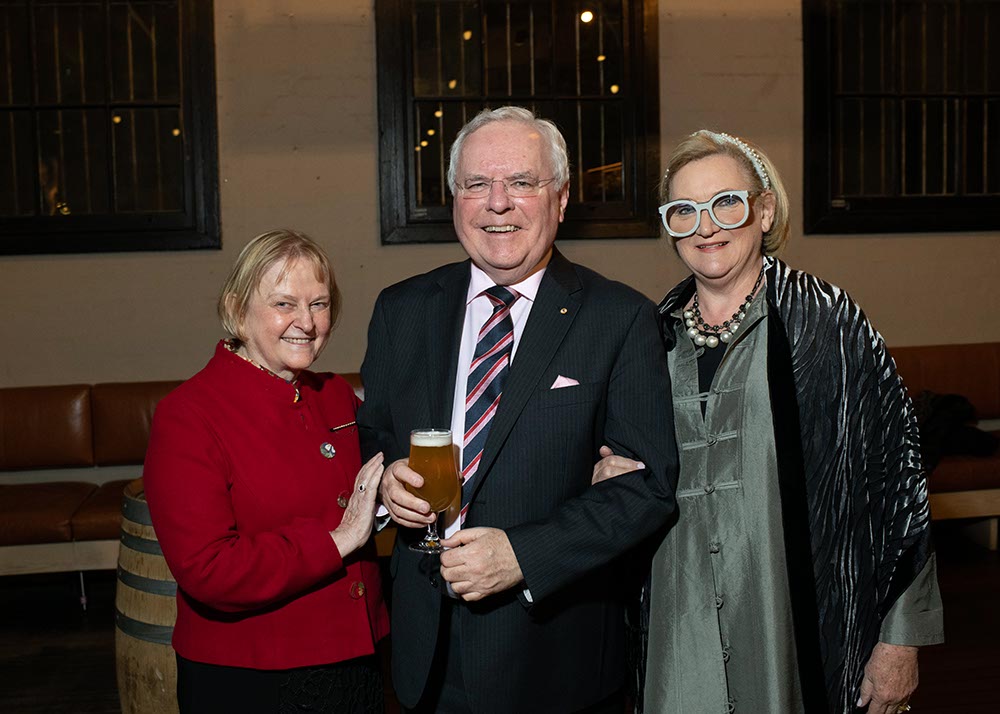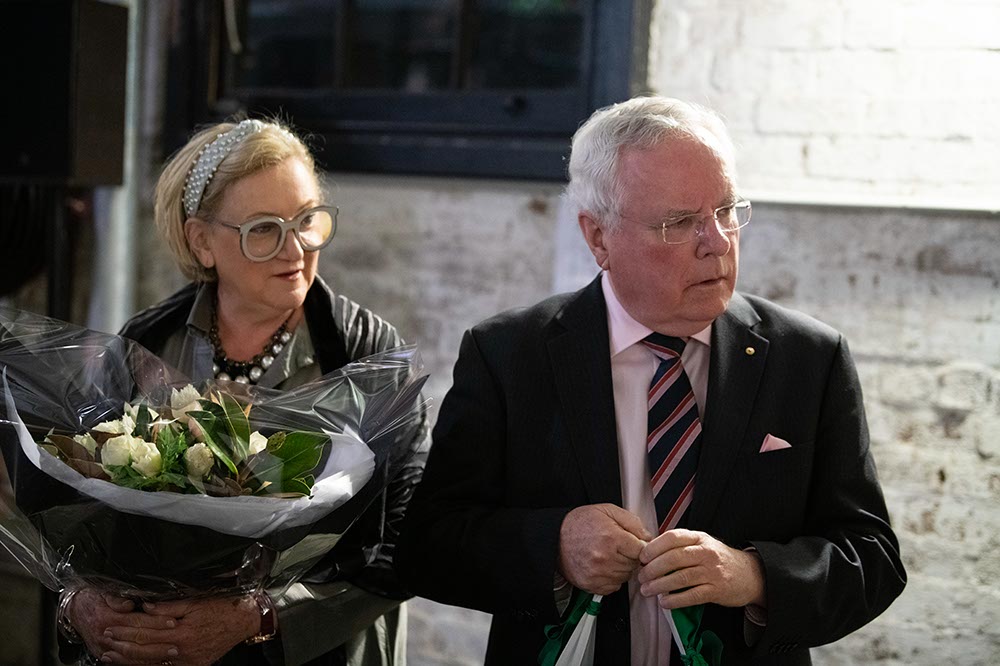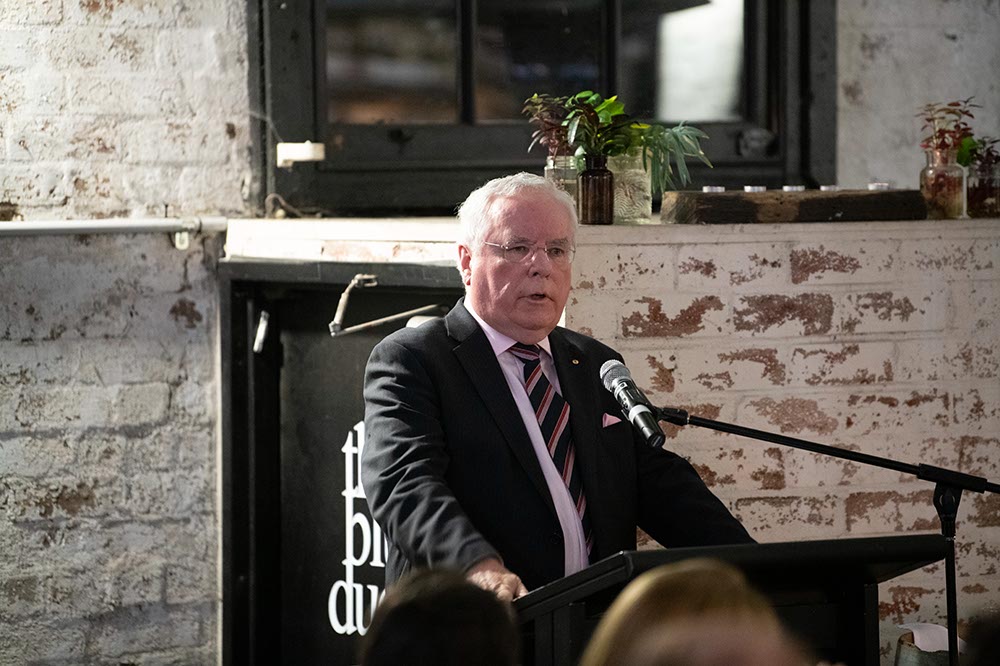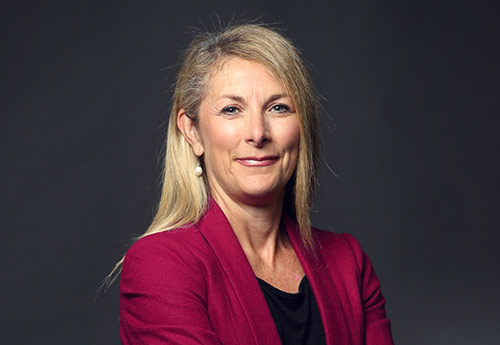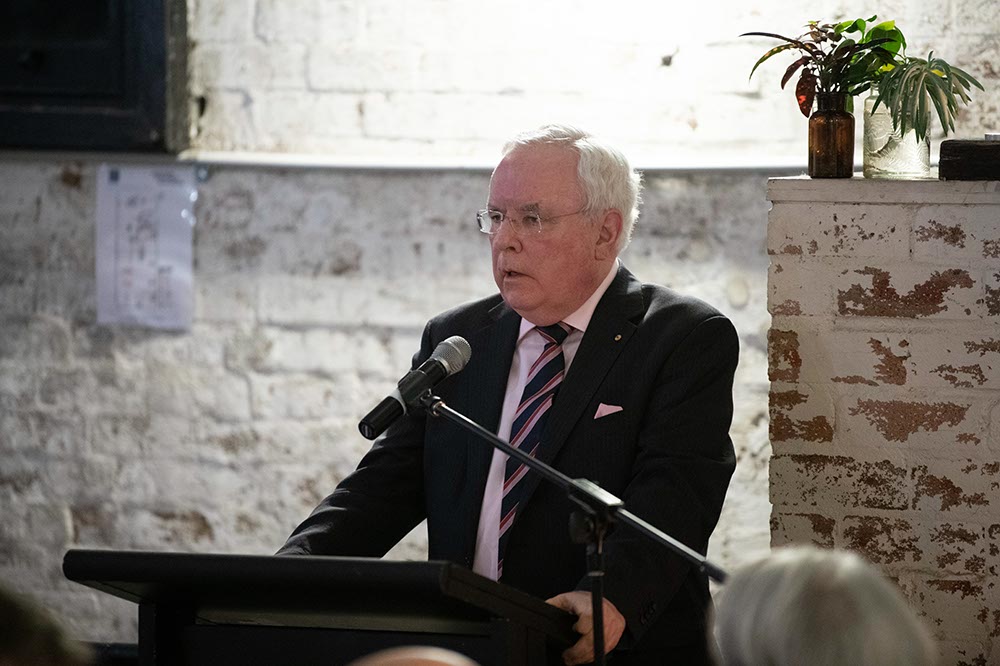Interview with Terry Sheahan AO

Bar News sat down to lunch with Terry Sheahan AO at Rockpool, following his recent retirement from the Land and Environment Court, to discuss his contribution to the law.
Bar News (BN): Terry Sheahan congratulations on your distinguished career in the law. As this is the ADR special edition of Bar News , let’s focus first on your contribution to ADR. What was your first encounter with the concept of alternative dispute resolution?
Terry Sheahan (TS): My first encounter with dispute resolution was my good luck in getting articles in the 1960s at a firm that was resolution focussed. It was a common law firm with a culture of settling as well and as quickly as possible.
I was haunted by the image of a little man called Mr Tesus who had a workers comp case that ran through the 1950s and the 1960s. He used to come into the office and he looked so forlorn. I will never forget the look on his face.
As to my first encounter with the phrase ‘alternative dispute resolution’ it was not a phrase with which I was then familiar.
While I was working in Yass in the mid 1970s, I acted for a number of farmers ruined by a bushfire, thought to have been caused by a failure of the local electricity supplier. With the willing collaboration of the defendant’s lawyers, I ran what would now be called a class action and settled the claims by what we would now call ADR.
As Attorney General, I followed Frank Walker who was a great reformer and I was anxious to do whatever was feasible to encourage a culture of dispute resolution in NSW.
BN: As Attorney General, in 1986 you were instrumental in establishing the first independent ADR organisation in Australia, the Australian Commercial Disputes Centre ( ACDC ). How did that come about?
TS: It was fortuitous that, not long after I became Attorney General, Sir Laurence Street AC KCMG QC had a conversation with the Premier, Neville Wran, about trying to attract international arbitration and dispute resolution to Sydney. Wran asked me if I had any ideas and I said ‘yes’.
I was able to get the Government funding to establish the Australian Commercial Disputes Centre. The idea for the centre hit a nerve with a number of people in the profession who supported it. As Attorney, I did my best to promote the centre as best as I could.
BN: After the 1988 election, you returned to legal practice and specifically to Cowley Hearne solicitors in North Sydney where you were Managing Partner. You practised extensively as a mediator before setting up Terry Sheahan Mediation and Consulting Services in 1995. What did you enjoy most about mediating?
TS: The obvious chemistry when parties were actually being listened to and not shielded from the management of their own disputes.
I had a lot of memorable moments mediating. A lot of debilitating experiences too! Fundamentally, it was all upside for me. I met a lot of wonderful people, including members of the Bar, like Robert Angyal and Mary Walker.
I was lucky with Cowley Hearne, too, as it was a firm that was very ADR minded. One of my partners was Harold Worksman, a pioneer in LEADR (Lawyers Engaged in ADR). I ended up being one of the five members of the NSW Chapter Committee of LEADR.
When I became Managing Partner of Cowley Hearne, I joined all the partners of the firm up to LEADR and we supported it very strongly. I had a good relationship with the ACDC, which I had helped found, and I was also active in the Law Society’s Dispute Resolution Committee.
BN: What were the key lessons you learnt along the way?
TS: Firstly, the mob has to keep up with you.
Secondly, it is fundamental to dispute resolution to spend some time working out what process you are going to use. I recall one matter I was asked to mediate, where it became apparent that every party in the room had a different concept of what Terry Sheahan was there to do: one party thought I was arbitrating; another thought I was giving an expert appraisal; another thought that, as a former Attorney General, I would provide a directed outcome. So I had to facilitate a negotiation as to what the dispute resolution process was going to be, which resulted in amendments being made to the standard mediation agreement. That matter settled because the parties were committed to the process agreed upon, which included a bit of proactive dispute resolution in the private caucuses which is usually outside the charter of a mediator.
Thirdly, people need to be comfortable with the person who is going to intervene in THEIR dispute.
BN: You have been described as 'an unwavering supporter of ADR in Australia'. Are you content to claim that appellation?
TS: Yes, I am happy to claim that. My commitment to ADR figured in my AO, too.
BN: Why are you so passionate about, and committed to, ADR?
TS: The fruit of the work is there to be seen. It works!
Not every case will settle through the traditional model of mediation. I did a mediation at one of the big firms. Their client was sitting in the room, as was the Japanese client on the other side. There was a lot of posturing by barristers around the table. In the end the client said 'hang on, I am paying for this! Hey Terry, can you and I and Yoshi go and have a quiet conversation together?' Of course, there was total uproar. But we did that and the matter settled within an hour.
Mediation is about the ability of people to understand the strengths and weaknesses of their position. I am not against people getting the best possible legal advice as to what their rights are. However, clients need to be told the reality of their position – after they have had a vent. They need to be asked: what is your objective? What do you want to do about your problem?
Unfortunately, there is a widespread problem in the profession of practitioners effectively hijacking a problem and litigating it and not facilitating a resolution. They say 'leave it to me'. Plaintiffs, particularly poor, underfunded plaintiffs, have no idea where they are. That is where mediation comes in.
BN: In your view, over the past 35 years, who are the individuals who have made a significant contribution to ADR here in NSW?
TS: We are very fortunate that Sir Laurence Street AC KCMG QC was such a champion of ADR but he was no more remarkable at the work than Trevor Morling or Kevin Lindgren. It is a coincidence that they were all superior court judges – having been a judge is not necessary to being a good mediator. And good judges do not necessarily make good mediators. There was amazing work done at the Workers Compensation Commission by mediators – solicitors and barristers – who took a good, practical, proactive approach to mediation.
BN: What is the future of ADR?
TS: The future is dependent on continued pressure for a better way.
I am not sure about mediation via computer. In my experience as a mediator, it is very important to see the whites of people’s eyes. I don’t know how you can assess frankness on a computer screen.
We need to change the culture of the profession and that cultural change will come with better education of the profession. It will not occur if ADR is only an elective subject in law schools. It needs to be a compulsory subject and law graduates need to join the profession with a mindset of dispute resolution.
Also, the heads of jurisdiction need to lead from the front, as in Canada.
The other thing to remember is that life is complex, so disputes about life are complex. Disputes are not always about what they seem. In the L&E Court context, an ostensible planning dispute may in fact be a commercial dispute between the parties. The issue is: what is the question in this case and how best to get the answer.
BN: You were Attorney General for just short of three years from 1984 until 1987. You were a very active AG. Did you come to the role with a clear plan of what you wanted to achieve?
TS: I had a couple of plans. I came to the job under Wran who had a particular view about the profession. He was very, very defensive of the profession. Very traditional in his attitudes to the Law and the way it operated. I don’t think I would have got the Judicial Commission through Cabinet if Neville was still the Premier.
By the time Unsworth was Premier, things were getting worse in relation to judicial scandals. We needed a process to deal with complaints about judges. I had the Judicial Commission in my mind. I had a real stoush with Sir Laurence about it. The Governor at the time, Sir James Rowland, asked me about that when I was at Government House on Executive Council business. I said: 'You better hope that I win Your Excellency or you will be trying Judge Ford in this very room' as that was the only procedure provided for in the relevant Act. He didn’t think that was a good idea.
The Judicial Commission was part of a package of reforms under Unsworth: the DPP; the Criminal Listing Directorate; amalgamation of the courts’ administration; and the centre piece was the Judicial Commission.
We went for what we could do.
BN: Your father, Bill Sheahan QC, had also been Attorney General in the 1950s. Did your father’s experience influence you in the role?
TS: I was only about nine years old when my father was Attorney General. He died in 1975, before I became Attorney General. However, even as a child I was aware that, as Attorney, my father had commenced reforms in relation to capital punishment, abolishing the death penalty for all but treason and piracy offences. Thirty years later, I completed those reforms as Attorney, abolishing the death penalty for treason and piracy.
I am not absolutely sure, but I think we may have been the only father and son to both hold the position of Attorney General in the whole of the Commonwealth.
My father achieved a lot of reform, particularly the repeal of the Lunacy Act.
BN: Of which achievement as AG are you most proud?
TS: The establishment of the Judicial Commission, without doubt, was my finest achievement. It was a major reform.
BN: You were appointed a judge of the Land & Environment Court in 1997. In 1984, you were briefly Minister for Planning and Environment in the Wran Government before becoming Attorney General. Did your time as Minister inform how you approached your role on the bench?
TS: Yes, definitely. It was a great job to have as Minister. As a judge, I had a very good understanding of the mechanics of the planning process in NSW. It troubles me that there are L&E practitioners who appear ignorant of how the planning system works in NSW.
BN: Is there a particular judgment of yours that stands out in your mind from your time on the Court?
TS: Yes, Newcastle Port Corporation v MS Magdalene. I put a tremendous amount of time into writing that judgment and getting it right – I put body and soul into that judgment. At the time I handed it down, it was not even reported, which surprised me, not least because the defendant was fined $1.2 million. I was recently told by a practitioner in the area (whom I bumped into in Japan) that it is now regarded as a leading case in maritime insurance law. I was delighted that that judgment was referred to at my swearing out ceremony by Gabrielle Bashir, who spoke on behalf of the Bar.
For very different reasons, the long running matter of Young v King also stands out as I had a terrible time with that. It started out as a dispute between two neighbours about relatively routine and minor drainage works. I wrote 14 judgments in that matter over the years. One of my colleagues, now at NCAT, said she was coming to my swearing out as she was sure I would be delivering Young v King No. 95.
Young v King was a case crying out for mediation but it was, regrettably, unsuccessful.
BN: You sat on the Court for approximately 22 years (with a stint at the WCC during that time which we will come to). What changes in the operation of the Court did you observe over that time?
TS: The development of the Court’s practice and procedure; the establishment of on-site hearings; the developing culture of ADR (particularly under the leadership of Brian Preston) – a culture of 'resolution'; all the Commissioners are now nationally accredited mediators; the recent appointment of Maureen Peatman because of the very fact that she has the knowledge and skills to settle large class 3 compensation cases; and the increasing workload of the Commissioners. They are the unsung heroes of the place. They do the lion’s share of planning work now. The Judges are doing less and less planning work.
BN: In 2001, you conducted a commission of inquiry into Workers Compensation Law in NSW and you were the inaugural President of the Workers Compensation Commission for six years from 2001–2007. As head of jurisdiction, you had your work cut out for you, which you well knew. Why did you accept the appointment?
TS: ADR and mediation were fundamental to the Workers Comp reforms in 2000. The opportunity to run the biggest ADR business in Australia was irresistible and to run it in my own way. I was given free reign by the Minister, John Della Bosca. I was pretty lucky.
It was a success, a bit of an adventure. However, I did not want to be away from the LEC as long as I was.
BN: What challenges, expected and unexpected, did you encounter?
TS: Prior to the reforms, the system was going broke because everyone was getting a cut except the workers. Only 13% of premiums were being paid out in benefits.
There was a culture where injured workers were being treated as if they were conducting an armed hold-up in asking to be compensated.
When I started at the WCC, I came from a court that had avant garde procedures, so the culture of the new WCC became similar to that of the L&E Court in a real sense. You can’t stop a culture developing if the leader is keen on ADR. You can be a denier, but in the end, the culture is going to roll right over the top of you.
The work practices of some of the profession in the jurisdiction were a disgrace. That required addressing.
At one point, Bob Carr, then the Premier, threatened to abolish the WCC. That was over a controversial case called Sinclair. I had awarded Sinclair compensation. The Government appealed. It was sent back to the WCC and I awarded compensation again.
In a lot of ways, being President of the WCC was a political job not a judicial job. I would not change those days. Reform is not for the faint-hearted!
BN: The Sydney Morning Herald reported on 23 October 2005 that you had given a speech that year in which you said you were nailing to the mast your intention, as head of jurisdiction, to criticise publicly, whenever convenient, any unprofessional behaviour which came to your notice. You appeared determined to call out what you saw as unacceptable behaviour on the part of practitioners in the workers comp jurisdiction, is that fair to say?
TS: I stand by everything I said in that speech. It was not everybody but as I said, the work practices of some of the profession in the jurisdiction were a disgrace. If I could get the Judicial Commission reform through in face of the opposition of the judges of the Supreme Court, I could deal with a few not very distinguished workers comp lawyers.
BN: What’s next for Terry Sheahan?
TS: I don’t know! I need to find all my stuff from my chambers. It is all in boxes in a storage unit.
I have just become patron of the Australian Dispute Resolution Association (ADRA) where I look forward to seeing some old faces.
My wife, Jenni, and I plan to relocate to our house in Bowral (we have not been able to spend any time there to date) and to do some travel. Trips to China, the UK and to see the Northern Lights in Norway are planned. We have just returned from a trip to Japan for the Rugby World Cup.
Jenni and I are also enthusiastic supporters of the Sydney Symphony Orchestra and the Ensemble. They have a wonderful program. You could be at something at the SSO every week.
Our families and grandchildren will also keep us busy.

Terry Sheahan AO with wife Dr Jennifer Hardy (right) and Maureen Peatman, Acting Commissioner of the Land and Environment Court (left).
